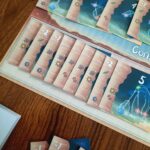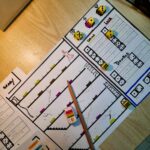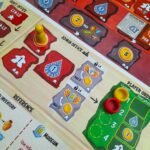Mon Repos

The beach at Mon Repos is beautiful, but beauty does not promise safety.
Under the quiet shimmer of moonlight, the sand stirs as the sea turtle hatchlings emerge, tiny bodies pushing forward toward the steady call of the ocean. And the journey is not an easy one…
Crabs linger at the edges, birds circle above, and distant waves hide dangers the young turtles cannot see. Still, they move, guided by instinct and the fragile certainty of life itself, hoping to make their way home.
If you could help them, would you?
Entry: before playing the game
First Impressions
These past few months I’ve had the fortune of playing amazing PNPs that kept nature close. Be it tending a plant in Growing Grounds or climbing the mountains of Colorado in 14ers, I seem to have a knack for such games. And by the looks of it, Mon Repos is another PNP I’m glad to add to this list.
As a game designer, I recently indulged in designing games that carry a healing, restorative narrative. It’s the kind of game that leaves you with that ‘good feel’ you sometimes need. As for Mon Repos, protecting the sea turtles and helping them find their way into the ocean fits perfectly into that space, and I’m all for it.
A bit on the game
In Mon Repos, your role is simple to describe but tricky to execute.
You guide sea turtles from their nests, across the beach, and into the ocean, turn by turn. And you have exactly nine rounds to give your best, so each move counts, and every choice can change the outcome. It gets tricky, as crabs block paths, birds swoop from above, and sharks lurk in the water, forcing you to plan ahead and weigh risks carefully.
There are bonuses and special actions associated with the treasures you collect from the beaches. This gives you the edge, but you have to use them at the perfect time. So from a glance, Mon Repos seems to be a game of timing, strategy, and largely incorporates opportunity cost.
All you need
Prints
The least you’ll need to print for Mon Repos is one beach sheet, called Sheet A in the game, and one scoring sheet, Sheet B, per player. There are multiple beach sheets to choose from.
If you want to take things to the next level, you can add Event Cards, which introduce positive and negative events that players must resolve each round. That adds four more pages to print.
If you want to play solo against an automa, you can use the CraboBot. For this mode, you’ll need to print the CraboBot sheet and its deck, which adds up to eleven pages.
Feel free to laminate Sheet A and B for replayability.
Non-prints
Grab three identical dice to represent the turtles’ movements, while grab another three but unidentical dice to represent the crabs, birds and sharks. These six dice will be rolled and allocated on the scoring sheet (Sheet B) on each round to navigate these creatures.
Next, grab six tokens or markers that will denote the turtles on the beach sheet (Sheet A). There are printable icon packs for these markers, as well as for the rest of the creatures in the game, which can make the game more immersive. I’m looking forward to trying them out in the future.
Finally, grab a pen. You’re ready!
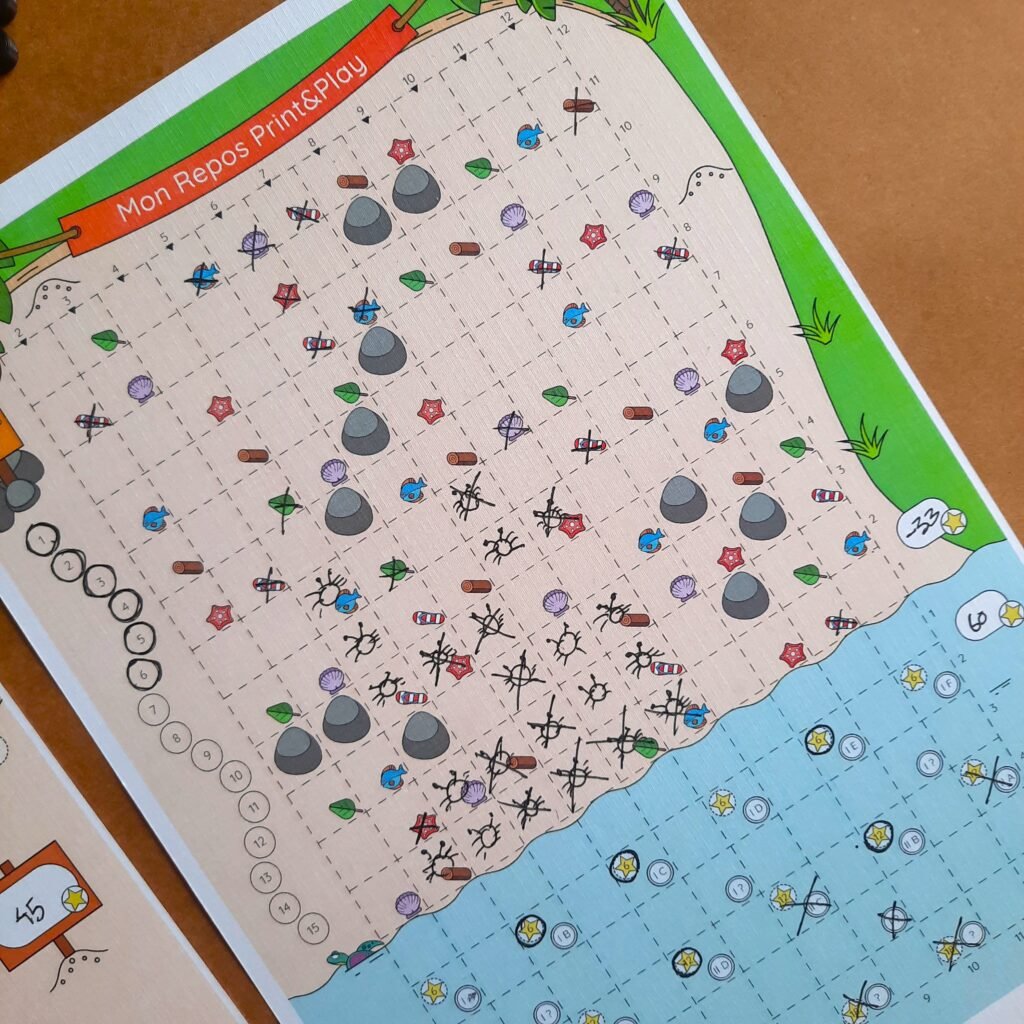
Entry: after playing the game
Findings
A multi-layered game
Guiding turtles to the ocean while dodging dangers and bagging some treasures along the way. Simple, isn’t it? Exactly what I thought. But it isn’t.
On every move, I asked myself:
+ Which turtles do I navigate this round?
+ Do I opt for bonus or scoring points?
+ Which treasures should I collect the most?
+ When do I use my bonuses and research actions?
+ How do I negate the threats?
+ How many turtles should I set free? How many is enough?
+ How do I handle the ever-growing population of crabs?
And more!
It’s amazing how just nine rounds of the game made me question so many decisions. The beauty of Mon Repos is that it’s not difficult. You can learn it in five to ten minutes, but it may take a round or two to play it well. It intricately adapts the principle of opportunity cost, so the more you play, the better you’ll get the hang of it.
PS: Opportunity cost is the value of the next best alternative that is forgone when making a choice. So, choosing one option means giving up the benefits of the other. In Mon Repos, you face it every round when you have to decide to allocate treasures either to earn bonuses OR score points and also win research actions. There’s no single formula for this, you really need to assess the situation each time you find yourself at a crossroads.
As a game designer, I love the principle of opportunity cost. I built Escape the Living Library around it, making every choice and every turn matter.
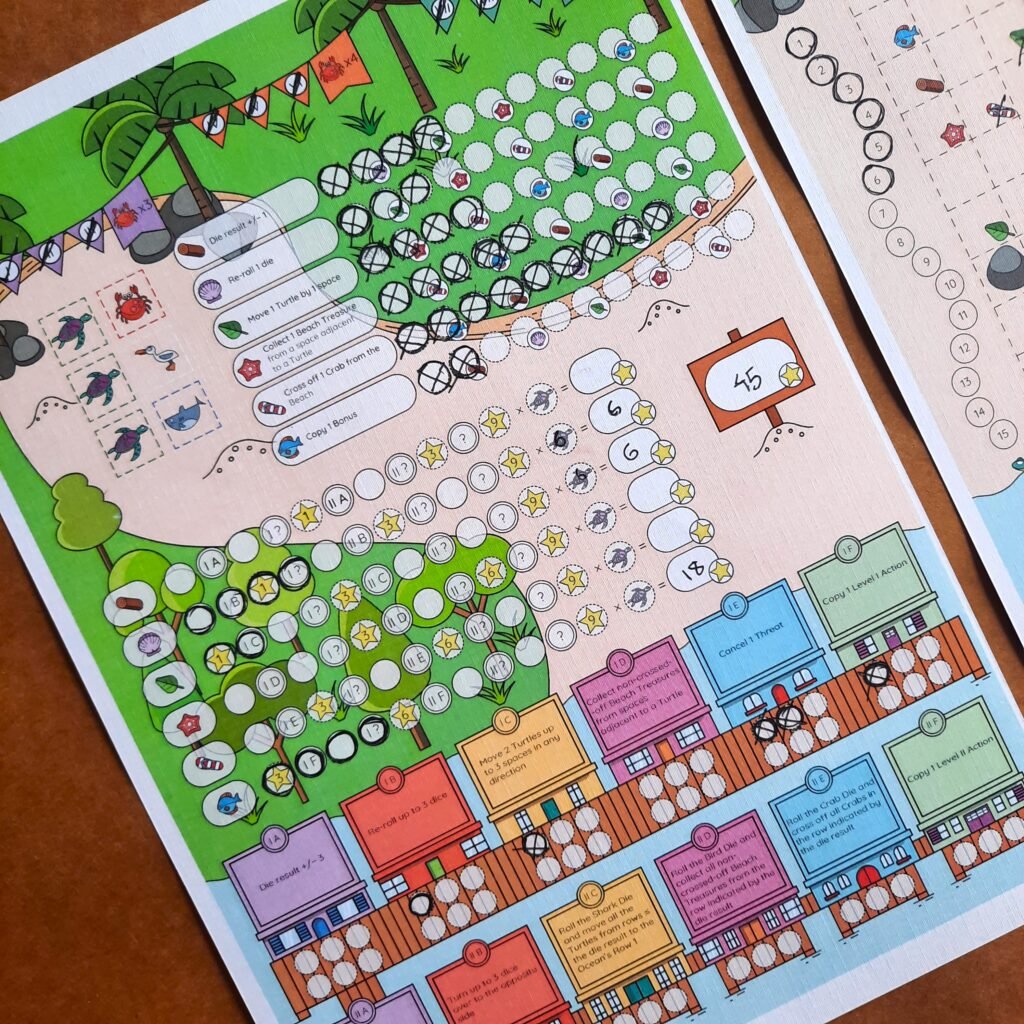
As practical as it can be
There’s no sugarcoating in Mon Repos. It’s a gamified version of reality, of wildlife at its purest form.
It’s not an easy path for the baby turtles as they leave the rookery and head for the ocean. Not everyone makes it, and the game does not conceal it. Every time my turtles were picked up by birds right at the edge of the ocean, or consumed by sharks moments after their first dive, my heart clenched. Not out of fear of losing points, but for what the turtles go through in real life. If nothing else, it made me care for them more than I did before. I know a bit more about their lives than I did yesterday. And that’s beautiful.
Not every game needs to be educational, but Mon Repos is certainly a strong contender. I feel it could be used to raise awareness of plastic pollution in future versions. We need to live through the turtles’ experiences to care more about them, even if it’s through a print-and-play.
Especially with print-and-play, in fact, having a smaller carbon footprint than traditional board games after all!
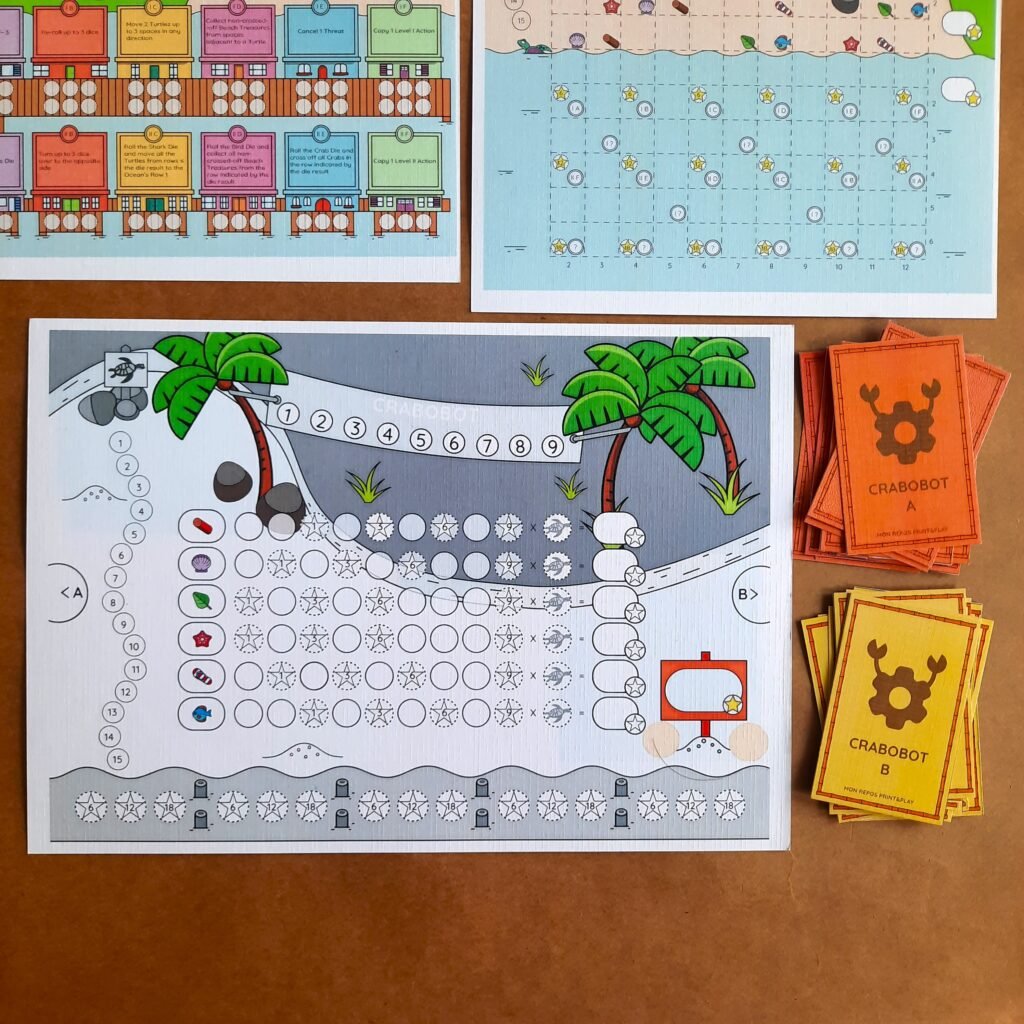
Replayable?
Judgement time! And this one will be easy.
There are eight beach sheets (Sheet A) available on the Kickstarter campaign, optional Event Cards that add an action (good or bad) on every turn, and the solo CraboBot mode to compete against a worthy opponent.
My verdict? The base game is replayable as is!
I played the base game with the first four beach sheets quite a number of times, and I’ve yet to even explore the Event Cards! I’ve attempted CraboBot mode once, and it makes the game more competitive, which is fun. I played the base game solo as well, and really enjoyed it. The base of Mon Repos is its biggest strength, while the rest of the touchup makes it all the more immersive.
Don’t be late!
I may have arrived at the beautiful beaches of Mon Repos a tad bit late, but I’d like to thank Mageek Games for giving me the chance to try this fantastic game.
Gamers, you only have less than six days to back this beauty!
Recommended items
Game Overview
Publisher: Mageek Games
Designer: Michał Marciniak
Number of players: 1-100
Difficulty level: Medium
Rounds of gameplay needed to learn: 1 to 2 rounds
Game duration: 30-45 minutes
Available on: Kickstarter
Theme: Roll-and-write | Opportunity Cost
Number of pages: Minimum 2, maximum up to 20-25 pages depending on the number of players.
Assembling difficulty level: Quite easy. No assembly is needed if you are playing only with Sheet A and B
Lamination: Recommended for replayability
Additional elements required: 3 identical dice, 3 unidentical dice, 6 tokens/trackers, and a pen per player
Time to learn: Within 20 minutes
Travel-friendly: 9/10
Shelving friendly: 10/10
Rating from PnP Time: 8.5/10

Tasliman is a board game developer based in Bangladesh, with the dream of exploring the world of games and introducing it to anyone new to it. He is the founder of Kraftz, a brand that develops board games commercially, as well as with reputed entities like BRAC and The Gates Foundation.

